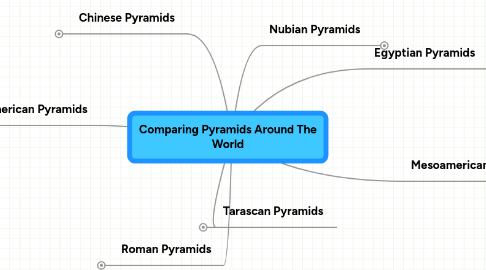Comparing Pyramids Around The World
by Pawel Chrzan


1. Tarascan Pyramids
1.1. The Tarascan state was a precolumbian culture located in the modern day Mexican state of Michoacán. The region is currently inhabited by the modern descendents of the P'urhépecha.
1.1.1. Tarascan architecture is noted for "T"-shaped step pyramids known as yácatas
2. Chinese Pyramids
2.1. The so-called pyramids of China are actually ancient mounds, most of which if not all were used for burial. Many of them are located within 100 kilometers of the city of Xi'an, on the Qin Chuan Plains in Shaanxi Province, central China. Although known in the West for at least a century, their existence has been made controversial by sensationalist publicity and the problems of Chinese archaeology under some regimes.
2.1.1. Some of chinese pyramids that we know about are The Tangut tombs near Yinchuan in Ningxia in northwestern China, a large number of tombs referred to as 'Chinese Pyramids'.
3. Roman Pyramids
3.1. The 27-meter-high Pyramid of Cestius was built by the end of the first century BC and still exists today, close to the Porta San Paolo. Another one, named Meta Romuli, standing in the Ager Vaticanus (today's Borgo), was destroyed at the end of the 15th century
4. North American Pyramids
4.1. Many mound-building societies of ancient North America built large pyramidal earth structures known as platform mounds. Among the largest and best-known of these structures is Monk's Mound at the site of Cahokia, which has a base larger than that of the Great Pyramid at Giza. While the North American mounds' precise function is not known, they are believed to have played a central role in the mound-building people's religious life.
5. Egyptian Pyramids
5.1. The Egyptian pyramids are ancient pyramid shaped masonry structures located in Egypt. There are over 100 pyramids in Egypt. Most were built as tombs for the country's Pharaohs and their consorts during the Old and Middle Kingdom periods
5.1.1. The best known Egyptian pyramids are those found at Giza, on the outskirts of Cairo. Several of the Giza pyramids are counted among the largest structures ever built. The Pyramid of Khufu at Giza is the largest Egyptian pyramid. It is the only one of the Seven Wonders of the Ancient World still in existence.
6. Mesoamerican Pyramids
6.1. Mesoamerican pyramids, pyramid-shaped structures, are an important part of ancient Mesoamerican architecture. These structures were usually step pyramids with temples on top – more akin to the ziggurats of Mesopotamia than to the pyramids of Ancient Egypt.
6.1.1. The Mesoamerican region's largest pyramid by volume – indeed, the largest in the world by volume – is the Great Pyramid of Cholula, in the Mexican state of Puebla.
